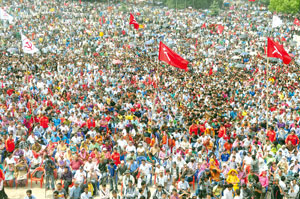 BIKASH DWARE |
A few days after the dissolution of the CA just before midnight on 27 May, Prime Minister Baburam Bhattarai had said, "This has hurt everybody and fingers will be pointed at each other, but once things cool down there will be no alternative but to come back to the table and forge a consensus."
One indication that things were cooling down and the leaders were ready to re-engage was the big parties meeting at the NC office in Sanepa on Wednesday. But the Maoist split, though expected, may complicate the work of a future unity government.
The 2006 Jana Andolan succeeded for two reasons: first, because the Maoists came out of the jungles to wage peaceful street protests alongside those opposed to an autocratic monarchy. Second, the NC, UML and other democratic forces were willing to engage with the Maoists in reimagining the structure of the Nepali state to include hitherto marginalised sections.
Had the Maoists insisted on overthrowing the state through violent means and Girija Prasad Koirala and Co refused to engage with them back then, more people would have been killed and the nation may have still been under royal-military rule.
After the CA dissolution last month, the NC and UML had retreated from agreements with the Maoists and this threw everything that followed the 12-point agreement of November 2005 into doubt. But the Maoist split seems to have galvanised the rump of the Maoist party and the others into action.
The interesting thing about the Maoist split is how disinterested everyone is. Prime Minister Bhattarai seemed to say he doesn't give a damn, by flying off to Brazil. There was a singular lack of drama and almost no reaction from the parent party.
It appeared by last week, Pushpa Kamal Dahal had come to accept what seemed to be inevitable and realised he can't have his feet on two boats anymore. With Bhattarai's growing international stature and Indian support, Dahal now realises he must do what he must do.
There was some jubilation in the NC and UML ranks after the Maoist breakup, but their hopes that the parent party will now be weaker may be premature. With the hardline wing having broken off, the NC and UML may have little to criticise the Maoists for.
After the formal split was announced, I spoke to leftist analyst Shyam Shrestha, who keeps a keen eye on goings-on within the Maoist party. "The Maoists will increasingly mainstream their programs in order to appease wider sections of the population," he told me, "they will look to form a long term coalition with the Madhesi parties and Janajatis based on their shared agenda on federalism."
The new Maoist party, although relatively small, include ideologues, wartime strategists and a substantial cadre base. It is ironic that even after pushing for the line of 'people's revolt' for all these years, when he got a new party for himself Baidya said armed struggle is not on his priority list for now.
The large number of weapons suddenly recovered from various places in the last few months suggests the parent party has made sure the comrades don't go back to the jungles.
In the coming days, there will be a unity of two diametrically opposing forces on the streets: the non-secular, anti-republican force led by Kamal Thapa and the anti-parliamentary party led by Mohan Baidya. Both will try to bring down the government. The question is will the NC and UML join forces against secularism, federalism and republicanism?
For their own sake, and the country's sake, let us hope they continue to engage the Madhesis and the Maoists and find a consensus on having closure on the constitution. The prospect of getting to power only makes sense when there is constitutional legitimacy to rule.
Read also:
The revenge of the radicals, KANAK MANI DIXIT
Mohan Baidya spinning off from UCPN-Maoist represents more than an interchange of punctuation marks



